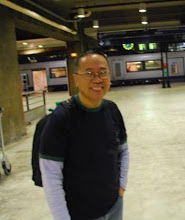In the Parish of Indang, Cavite (est. 1625) dedicated to San Gregorio Magno (St. Gregory the Great), there not only flourishes a profound devotion to its great patron, but also to the 7 Archangels: Baraquiel, Gabriel, Judiel, Miguel, Rafael, Sealtiel, and Uriel.
Town lore has it that a painting of the 7 angels was found rolled up in a trash heap behind the church. The unsigned Archangels painting was a local painted version of an 16th century print made by Flemish engraver Hieronymus Wierix (1553’d. 1 Nov.1619) who did many religious prints.
The ancient painting, in a shadowbox frame, was enshrined on one side of the altar, and it
was in this manner that the people’s devotion came to include the 7 archangels.
Indang’s town fiesta, celebrated on the
2nd Sunday of May and the following Tuesday, honors their joint
patrons– the pope-saint, San Gregorio Magno, and the Seven Archangels. Their actual feast days are marked separately: Sep. 3 and Sep. 29, respectively.
Show here are the old statue carvings of the Seven Archangels which were meant to be used for processions.
SAN BARAQUIEL. Chief of the guardian angels, a patron of family and married life. He is also invoked as the special guardian of those born on Saturday. Symbols: include a wreath of white roses or a book, representing marital and family guidance. Traditions associate him with power over lightning and storms, as his name can also be interpreted as "lightning of God.
SAN GABRIEL. Messenger of God; known for delivering significant messages, such as the announcement to the Virgin Mary that she would give birth to Jesus. Patron saint: Gabriel is considered the patron saint of messengers, communication workers, and postal workers. Symbolic attributes include a white lily, representing purity, and a trumpet.
SAN JUDIEL. His name—from “Jehudiel”--means "Praise of God". Patron saint of all those in positions of responsibility and encourages those in their work. Often shown holding a crown (reward for spiritual labor) and a whip or a three-thonged whip (punishment for sinners).
SAN MIGUEL. Prominent warrior archangel, leader of God's armies, specially for his role in vanquishing Satan. Venerated as a champion of justice, a healer, and the guardian of the Church. Depicted with a sword, a banner, or scales, and sometimes shown stepping on a dragon.
SAN RAFAEL. His name means "God has healed," and he is invoked for divine healing. He served as a guide for Tobit, hence, also patron of travelers and pilgrims. Often shown holding a staff or a fish, the latter symbolizing the healing powers he used from a fish's gall to cure Tobit's father's blindness.
SAN SEALTIEL. San Sealtiel. The angel of prayer and worship, believed to help people with their prayers, guide them in worshiping God, and present their petitions to God. Often depicted holding a censer (thurible), with arms crossed in prayer.
SAN URIEL. San Uriel. The angel of wisdom, prophecy, truth, and light. His name means "God is my light" or "fire of God". Often depicted with a book or scroll and sometimes with a solar orb. In some traditions, he is the one who wields the fiery sword at the gate of Eden.
CREDITS:
All photos, Dr. Raymundo Feliciano Albums, 1994.
Phtoto of the 7 Archangels of Indang: wikimedia commons

































































